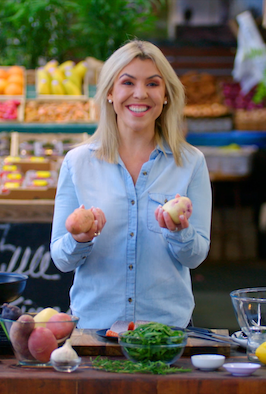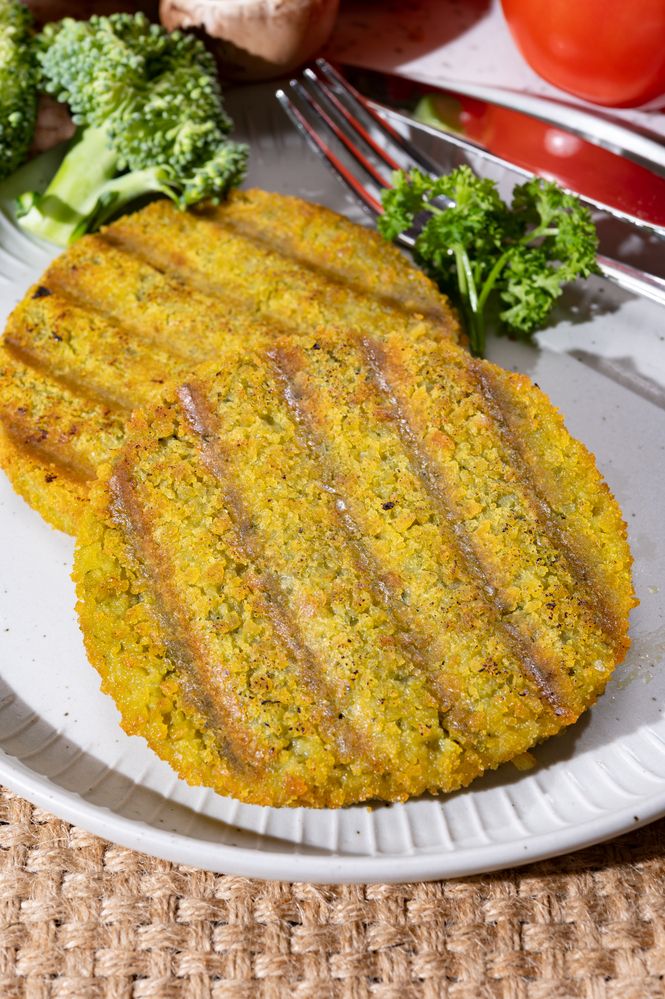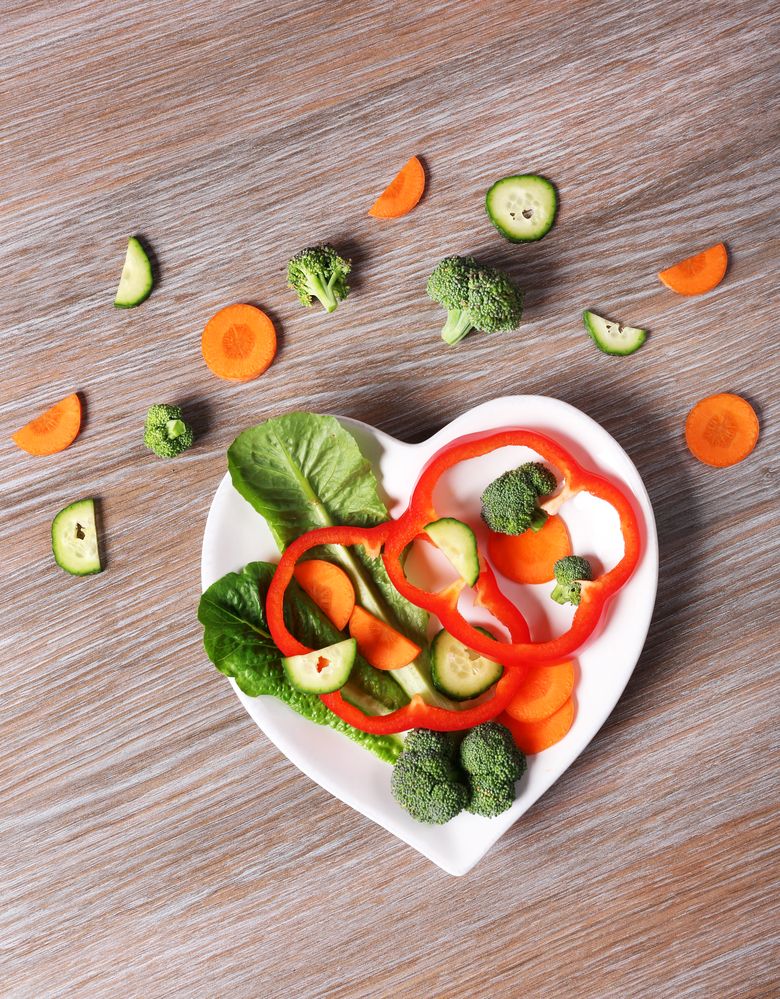7 most-asked questions about trans fats
Written by Catherine Saxelby
on Thursday, 25 March 2010.
Tagged: fat, fats, oil, take-away, technology

Monounsaturated fats are "good"; saturated fats are "bad"; but what about trans fats? They've been banned in California and listed on fast food menus in New York. How bad are they really? I've sorted through the research to bring you the answers to 7 essential, need-to-know queries.
1. What are trans fats?
They are chemically classified as unsaturated fatty acids but the molecules have been "rearranged" or "straightened" so they act like saturated fatty acids in the body. Compare oleic acid, a common monounsaturated fatty acid in many foods, with its trans cousin elaidic acid below. Both have the same number of carbon atoms but oleic is bent at the double bond while elaidic (the trans one) sits straight in line - which alters the way it behaves in food manufactaure.
Here is oleic acid (a monounsaturated fatty acid) with 18 carbons and a bend or 'kink' in the middle of its long chain at the double bond:

Here is elaidic acid (a trans fatty acid), also with 18 carbons in its chain, but no 'bend' at the double bond.

2. Why are trans fats used?
They have a higher melting point than non-trans or "cis" fats. This means they are more solid at room temperature and under heating which makes for crisper biscuits and crunchier chips, nuggets and corn chips. They are also more stable, less likely to go rancid so have a longer shelf life.
3. Are they synthetic or natural?
One type of trans fats is made by bacteria in the forestomachs of cattle, sheep, goats and deer and so occur naturally in the meat, milk and other products derived from these animals.
The other worrying type of trans fats is formed through the hydrogenation of liquid vegetable oils. They're the one nutritionists are concerned about.
4. What's the problem with industrial trans fats?
They increase your total cholesterol and "bad" LDL cholesterol levels and lower your "good" HDL cholesterol level, causing a deficiency of essential fatty acids. This significantly increases your risk of heart disease, type 2 diabetes and possibly infertility.
5. Is it worse in the US than in Australia?
Yes! In the US they've had to hydrogenate soy bean oil to produce hard commercial fats so their intake is much higher than ours. The average American consumes 2 to 3 per cent of his/her daily kilojoules from trans fats compared to 0.6 per cent for an Australian. What's more, most of our trans fats are naturally occurring and have not been shown to be dangerous.
Thanks to the Heart Foundation, which has been pushing manufacturers to get rid of industrial trans fats, we've been using palm oil which is high in saturates so already a semi-solid with good shelf life so doesn't need to be hydrogenated. It contains little trans fats but it's still not good for your heart.
6. Where do trans fats lurk?
At present most food labels show ONLY the total fat and saturated fat which makes it hard to track them down. Manufacturers have to list the trans fat only when they make a claim about them such as "Free of trans fat". Most margarines tell you their trans fat content as it's so low - usually less than 0.1 per cent.
As a general rule, foods likely to contain higher levels of trans fats are "junk food" - crisps, doughnuts, muffins, fast food, fried food, crisps, pies, doughnuts, microwave popcorn, instant fried noodles, meat pies, sausage rolls, apple pies and croissants- so eat less of those and you'll automatically reduce your intake.
7. Trans OR saturated fats - what's the real worry?
In Australia trans fats are not the problem they are in the US. What we do need to worry about is the amount of saturated fats we consume. So remember, don't choose foods based on trans alone try to choose products with the lowest total saturated plus trans fat content possible.
Trans fats in the news
Professors call for removal of industrial trans fats Two Harvard Medical School professors argue that removing industrial TFAs - with their partially-hydrogenated fats - is one of the most straightforward strategies for rapid improvements in health. They point to Denmark and New York City where legislation has forced removal of trans fats with no loss of food availability, taste or affordability. For instance, they say in New York restaurants, the prevalence of use of trans fat has declined from 50% to less than 2%. Editorial in British Medical Journal April 2010. Read more
Two Harvard Medical School professors argue that removing industrial TFAs - with their partially-hydrogenated fats - is one of the most straightforward strategies for rapid improvements in health. They point to Denmark and New York City where legislation has forced removal of trans fats with no loss of food availability, taste or affordability. For instance, they say in New York restaurants, the prevalence of use of trans fat has declined from 50% to less than 2%. Editorial in British Medical Journal April 2010. Read more
Surveys on the intake of trans fats
 Check out reports on how much trans fats we eat in Australia and New Zealand and what foods are the culprit contributors in this series of excellent reports from the food regulator FSANZ: Intakes of Trans Fatty Acids in New Zealand and Australia; Risk Assessment Report; Round table on Trans Fats in Quick Service Restaurants - Report on voluntary initiatives to reduce trans fatty acids in the the Australian Food supply. Read more
Check out reports on how much trans fats we eat in Australia and New Zealand and what foods are the culprit contributors in this series of excellent reports from the food regulator FSANZ: Intakes of Trans Fatty Acids in New Zealand and Australia; Risk Assessment Report; Round table on Trans Fats in Quick Service Restaurants - Report on voluntary initiatives to reduce trans fatty acids in the the Australian Food supply. Read more
In 2015, the Food and Drug Administration gave the food industry three years to remove industrial trans fats from the American diet. This follows its statement that partially-hydrogenated oils (PHOs), the source of artificial trans fats, were no longer “generally recognized as safe.” It is also present at very low levels in some oils, where it is unavoidably produced during the manufacturing process. In addition, food companies can petition FDA for specific uses of certain partially hydrogenated oils which are needed for special food uses. Read more from FDA
Reviews
-
Read more
Product review: Low-sugar alcoholic ginger beer
1 March 2023 by, Catherine Saxelby
Want something to drink before dinner? Something that’s LOWER in alcohol than wine? To match his beer? Then look no further than Bundaberg’s low-sugar alcoholic ginger beer.
You can drink Bundaberg low-sugar ginger beer straight from the can, or pour it into a long glass over ice with a slice of lime.
-
Product snapshot: Berkelo’s Khorasan Macaroni
14 September 2022 by, Catherine Saxelby
I’m loving this macaroni from Berkelo. I was sent a sample for Whole Grain Week 2022 by the Grains Legume Nutrition Council. I cooked it up and found that it was just divine! Read on for more …
-
Product review: Super high-oleic safflower oil
11 May 2022 by, Catherine Saxelby
“What does super high-oleic mean?” I hear you ask. Also, “I haven’t heard of safflower for ages. What’s the deal?” Read on and all will be explained.
-
Product review: Healthy Life Food Tracker
6 April 2022 by, Catherine Saxelby
When I was first asked to write this review, I thought, Not another tracker.
After all, there have been several in recent years, such as My Fitness Pal and Everyday Diet Diary. But this one is different. It works by using your Everyday Rewards card AND your shop at Woolworths.
-
20 October 2021 by, Catherine Saxelby
With home delivery on the rise, this post is reviewing none other than that stalwart Lite n’ Easy. We all know their meals are good for weight loss (which we all need after COVID-19!), but did you know they’re also good for general health and wellbeing ? Eating well to nourish yourself – putting your mental health and wellbeing at the forefront – is gaining momentum. Lite n’ Easy meals also ensures you satisfy your need for vitamins, minerals, fibre and phyto-compounds, such as sterols and carotenoids.
 This post has been sponsored by Lite n' Easy.
This post has been sponsored by Lite n' Easy. -
Product review: Birds Eye Plant Based range
15 September 2021 by, Catherine Saxelby
When you think of Birds Eye, their frozen peas and fish fingers probably come to mind. But I bet you’d never think of plant-based products!
 This post has been sponsored by Birds Eye.
This post has been sponsored by Birds Eye. -
Product Snapshot: Olina’s Snackers Crackers
2 June 2021 by, Catherine Saxelby
We sampled Olina’s latest offering in the seeded cracker range – called Olina’s Bakehouse Seriously Seedy Snackers (which is a great name BTW). They come in four flavours: Barbecue, Chilli & Lime, Beetroot & Sour Cream, and Balsamic Vinegar & Caramelised Onion. Take a look at our verdict.
Healthy Weight Loss
-
Read more
Intermittent fasting vs daily calorie restriction
3 May 2023 by, Catherine Saxelby
As you probably know already, intermittent fasting (IF) has gained favour as an alternative regimen to daily caloric restriction (DCR). Fasting is shown to extend the lifespan of rats, and has been associated with metabolic benefits in humans, yet the results so far have been inconsistent. So, which regimen is best for healthy weight loss?
-
15 March 2023 by, Catherine Saxelby
What sort of a diet should you follow to lose that excess weight? These days, it’s pretty confusing with high-protein Keto advocates clashing with plant-protein followers … as well as intermittent fasters, juice-only dieters, no-carb dieters and no-animal (aka plant-based) dieters. Plus all the ads for anti-hunger supplements, meal-replacement shakes and home-delivered meals, more of which somehow appear every day. So, what sort of diet should YOU follow to lose that excess?
-
Protein shakes for weight loss
9 November 2022 by, Catherine Saxelby
These days, protein shakes aren’t bought by just body builders – they’re so popular that you can readily buy a 400 g tub at your local supermarket or service station. And with tempting claims such as ‘Facilitates muscle toning’, ‘Contains transformation-making protein’ and ‘Tastes incredible, mixes easily’, why wouldn’t you grab one? But protein shakes aren’t the magic answer to all your weight-loss woes. Let’s take a look at what you get for your money.
Guest post by dietitian Zoe Wilson APD
-
20 January 2021 by, Catherine Saxelby
Many of us have cravings from time to time and for different reasons. One thing is certain, they can sabotage all your best efforts at a healthy diet and/or weight loss. The good news? You CAN beat them. I’ll tell you how.
-
How to lose weight WITHOUT going on a diet
14 October 2020 by, Catherine Saxelby
The word 'diet' is a turn-off for most people. It sounds hard, unpleasant and unpalatable. Losing weight doesn’t have to be hard AND it doesn’t have mean sticking to a 'diet'. You can forget Paleo, Keto, Vegan and Raw, Gluten-free and Intermittent Fasting. To lose weight, you don’t have to follow any specific diet. What you need is simple, healthy, nutritious food and a few tips and tricks.
-
What IS a healthy balanced diet for weight loss?
16 September 2020 by, Catherine Saxelby
Healthy weight loss happens when you lose weight slowly and steadily (around 1 kg or 2 pounds weight loss a week). Your goal is to lose weight while still getting your essential nutrients but from smaller portions. You certainly don’t want to be tired with no energy! That’s why you need regular healthy meals and snacks on hand to ensure your vitamins, minerals, omega-3s and fibre needs can be easily met. There is a new range of healthy weight loss meals available and it’s one that I’d like to recommend. With these ready meals, you’ll say goodbye to meal planning, shopping, meal preparation and cooking.
This post is sponsored by Chefgood
-
Kitchen make-over for the New Year
8 January 2020 by, Catherine Saxelby
“This year, I'm going to lose weight!”, or “This year I’m opting for a healthier lifestyle!” Is your 2020 New Year's resolution something like one of these? If so, how is it going to happen?
Most popular
-
Read more
Q. What's the difference between Diet Coke and Coke Zero?
12 September 2013 by, Catherine Saxelby
A. At first glance, Diet Coke and Coke Zero appear to be identical. Both contain no kilojoules (Calories) and no sugar. Both are artificially sweetened with (the same amount) of aspartame and acesulfame K and therefore have the same ‘sweetness’.
-
How to convert sodium to salt (and salt to sodium)
6 August 2010 by, Catherine Saxelby
As a nutritionist, my aim is to help busy women eat healthily. One of the ways to do this is to follow the general nutrition advice to reduce the salt in your diet. So, how can you do this when what you’ll see on a food label and on any recommended daily intakes is sodium?
-
7 types of sugar - which is healthier?
11 December 2013 by, Catherine Saxelby
Last week on the radio, the announcer asked me if there was a 'good' sugar – one that would satisfy her sweet tooth but that was 'healthier' than regular white sugar. She figured if there were 'good' carbs and 'bad' carbs there must be some sugars that would get the nod of approval from nutritionists.
-
Eat to beat gastro and diarrhoea
12 October 2012 by, Catherine Saxelby
A clear fluid diet is the best form of treatment for gastro and tummy upsets. It is the "lightest" type of diet, designed to place as little strain as possible on the digestive tract. It is NOT nutritionally adequate and should be followed only for a strictly limited time e.g. two or three days but no more than a week.
-
Nutella. The full (correct) list of ingredients
12 April 2011 by, Catherine Saxelby
Have you ever tried to find the exact list of ingredients for Nutella online? The identical one that appears on its label - in descending order from the first (largest ingredient by weight) to the last ingredient, as required by law? Well, you won’t find it! Here’s the hoop-la I went through to discover exactly what the ingredients in Nutella are and why Nutella is not good for your kids.
-
Sugar - why quitting sugar guarantees you'll lose weight
6 May 2013 by, Catherine Saxelby
Sugar. It's been labelled "deadly", "addictive", "toxic", "sweet poison" and blamed for the rise in global obesity in recent years." Get rid of the white toxin from your diet and you'll free up your body to drop those excess kilos" (or so say anti-sugar campaigners Sarah Wilson, David Gillespie and Robert Lustig). Here are the three real reasons why I believe quitting sugar helps you lose weight.
-
What does 8,700 kilojoules look like?
14 August 2012 by, Catherine Saxelby
8,700 is a magic number in nutrition. It’s the number of kilojoules (kJ) that is the “average” intake for adults in Australia, if the surveys are correct.
It’s widely used as a benchmark figure and as the basis of food labels such as the Percent Daily Intake values.
Recently kilojoules have appeared on fast food menu boards and they use 8,700 as the yardstick to assess their foods against. Here's my take on it.
Recipes
-
Read more
24 May 2023 by, Catherine Saxelby
This is a kind of pavlova topped with fruit, but the base is made from ricotta, rather than egg whites and sugar.
-
22 March 2023 by, Catherine Saxelby
This is an Asian-influenced salad that’s perfect to serve as a side salad at a BBQ or with a fillet of fish.
-
14 December 2022 by, Guest Post
This banana loaf is half bread and half cake. Hence I've called it "cread" which is halfway! It’s dense and delicious without being super-sweet or oily. It can be enjoyed fresh, toasted or sliced and frozen into portions to enjoy later.
-
23 November 2022 by, Guest Post
This quick and easy dessert is ready in minutes. And there are NO leftovers to tempt you later!
-
19 October 2022 by, Catherine Saxelby
A quick and easily-made sandwich, it’s great for an easy lunch.
-
Spring Vegetable Pesto Pasta Salad
7 September 2022 by, Guest post
This super salad-in-one gives you pasta plus vegetables all together. It has a spring feel to it.
-
Squash-ed spaghetti bolognaise
3 August 2022 by, Guest post
This is an excellent make-and-freeze recipe, so weeknight meals become more manageable. I know of no better way of ‘hiding’ veggies than in a Bol sauce – somehow mince with a few veggies like pumpkin or zucchini is a match-made-in-heaven.
Foodwatch
The Good Stuff
The Boring Stuff
© 2025 Foodwatch Australia. All rights reserved
Website by Joomstore eCommerce









































